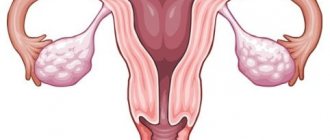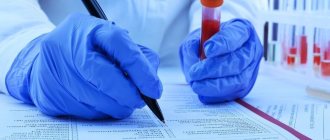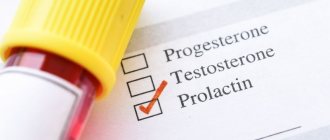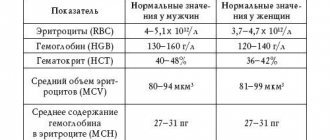Human chorionic gonadotropin, or hCG, is a protein produced by the membranes of a developing embryo. It is responsible for the course of pregnancy, blocking menstruation, and helps increase the concentration of hormones that are needed to preserve the fetus. The presence of hCG in a woman’s blood is one of the early signs of conception. It must be said that the human pituitary gland produces a small amount of hCG, so in some cases a small concentration of it can be found in the blood of men and women (including those in menopause).
HCG: role in the body
The main function of hCG is a signal that a woman’s body needs to be rebuilt in connection with the onset of pregnancy. It affects sex hormones, activates increased production of estradiol, progesterone and estriol, which change the hormonal background of the expectant mother. By monitoring the activity of hCG, you can assess how the fetus is developing and what the likelihood of miscarriage is.
Content
- HCG: role in the body
- Are hCG and beta-hCG the same thing?
- Types of hCG tests
- HCG during pregnancy
- Reduced concentration of hCG during pregnancy:
- Increased concentration:
- Analysis for hCG in non-pregnant women
- hCG in men
- How to donate blood for analysis?
Human chorionic gonadotropin (hCG) in Moscow from day 1
from 450 ₽
Sign up
Pregnancy-associated plasma protein A (PAPP-A) in Moscow from day 1
from 850 ₽
Sign up
Placental lactogen in Moscow from 10 days.
from 880 ₽
Sign up
Starting from week 7, gonadotropin is responsible for the development of the corpus luteum, maintaining its functionality. There is an assumption that it suppresses the mother's immune system, due to which the fetus is not rejected.
Reference! The pregnancy test strip is based on a method for assessing the level of human chorionic gonadotropin in the blood. But in this case, the material being studied is urine, and in it the concentration of the hormone increases more slowly. Therefore, if a blood test can detect pregnancy on the second day after fertilization, the test can do this only after 7 days.
Reasons for increasing hCG
You can find out how hCG should grow during pregnancy from the table. But there are a number of factors that provoke an increase in human gonadotropin. This occurs when the following occurs:
- Multiple pregnancy (if twins or more children are expected).
- Developmental defects of the unborn baby and the presence of chromosomal abnormalities .
- Diabetes.
- The use of human chorionic gonadotropin for treatment.
- Trophoblastic tumors.
Types of hCG tests
The following types of tests for human chorionic gonadotropin are distinguished:
- General - prescribed for diagnosing conception (on the 2nd day after fertilization, when the test strip cannot yet show the correct result). If there are no pathologies and the pregnancy proceeds normally, in the first weeks the hCG level doubles every two days, and reaches its maximum values by 10–11 weeks of gestation. After this, its level decreases. In multiple pregnancies, the hCG level increases in accordance with the number of fetuses.
- Free β-hCG - analysis shows the presence of testicular and trophoblastic neoplasms. It is also used in screening studies in the 2nd and 3rd trimester to exclude Edwards and Down syndrome. If a positive result is observed, the woman is transferred to the risk group, but this cannot be a 100% guarantee of the occurrence of chromosomal mutations in the fetus. The age of the pregnant woman over 35 years, a family history of Down's disease, the presence of genetic defects in close relatives, and radiation exposure are indications for a more thorough study of hCG. In all other cases, this test is prescribed at 8–13 and 15–20 weeks of pregnancy.
Decrease in indicator
A decrease in the amount of hCG is diagnostically significant during pregnancy. The deviation of the indicator from the norm, a slow increase in the concentration of the hormone, and a stable level for 1-2 weeks are assessed. The reasons may be:
- Pathologies of pregnancy
. In the early stages, low test values reflect ectopic implantation of the embryo and arrested development of the embryo/fetus. - Risk of miscarriage
. In the first trimester, a progressive decrease in value reveals the risk of spontaneous abortion. - Fetoplacental insufficiency
. A decrease in analysis values is characteristic of chronic insufficiency of placental functions. - Antenatal fetal death
. In the second and third trimester, a sharp decrease in the amount of hCG is determined by the intrauterine death of the unborn child.
HCG during pregnancy
| Period (weeks after conception) | HCG indicators |
| 1–2 | 25–156 |
| 2–3 | 101–4870 |
| 3–4 | 1110–31500 |
| 4–5 | 2560–82300 |
| 5–6 | 23100–151000 |
| 6–7 | 27300–233000 |
| 7–11 | 20900–291000 |
| 11–16 | 6140–103000 |
| 16–21 | 4720–80100 |
| 21–39 | 2700–78100 |
Reference! The data presented are averages; in addition, each laboratory has its own unit of measurement of hormone levels and its own rating scale.
Reduced concentration of hCG during pregnancy:
- If the indicators decrease by 50% or more relative to the norm, we can talk about an existing threat.
- Fetal development problems.
- Chromosomal abnormalities in the fetus, such as Edwards syndrome.
- With a sharp decrease in indicators in the second and third trimester, a frozen pregnancy or fetal death is possible. In this case, at the beginning, hCG is normal, and then stops increasing or decreases sharply.
- Ectopic pregnancy.
- Diabetes.
- If the concentration of the hormone decreases in the later stages, post-term pregnancy is possible.
If the analysis result shows a low level, do not immediately panic and draw conclusions. The gynecologist could have made a mistake with the date of expected conception, which happens quite often when a woman gives inaccurate information about her cycle, on the basis of which the day of ovulation is calculated.
Increased concentration:
- Early toxicosis.
- Postmaturity of the fetus.
- Incorrect deadline.
- Chromosomal abnormalities - if hCG rises sharply in the 2nd trimester, the fetus may develop Down syndrome.
- Multiple pregnancy - in this case, the level of hCG in the first weeks of pregnancy may exceed the norm by 2-3 times. This is due to the fact that the hormone is produced by several membranes at once.
Decoding the results
A table of hCG values by week allows you to see the concentration of beta gonadotropin and monitor the norm. When the fertilized egg begins to grow, laboratories are guided by a table depending on the duration of pregnancy, deviations are determined so that the woman can see a gynecologist on time.
Table of normal hCG values during pregnancy by week:
| Duration in weeks | Average units mIU/ml | Normal limits mIU/ml |
| 2 | 150 | 50-300 |
| 3-4 | 2 000 | 1 500-5 000 |
| 4-5 | 20 000 | 10 000-30 000 |
| 5-6 | 50 000 | 20 000-100 000 |
| 6-7 | 100 000 | 50 000-200 000 |
| 7-8 | 80 000 | 40 000-200 000 |
| 8-9 | 70 000 | 35 000-150 000 |
| 9-10 | 65 000 | 32 000-130 000 |
| 10-11 | 60 000 | 30 000-120 000 |
| 11-12 | 55 000 | 27 000-110 000 |
| 13-14 | 50 000 | 25 000-100 000 |
| 15-16 | 40 000 | 20 000-70 000 |
| 17-20 | 30 000 | 15 000-55 000 |
For example, at the 3rd week of pregnancy the hormone concentration is considered normal and 600, 700, and 900 mIU/ml, and at the 5th week the level can be 7000, 8000, 9000, 10000 and more - the intensity of the level increases, then, starting from the 8th week , there is a decrease in hCG levels.
There is a table of hCG values for in vitro fertilization. It allows you to track the correct dynamics immediately after the IVF procedure.
It should be noted that only a specialist will provide the correct interpretation of the results of an analysis for the hCG hormone, so you should not draw independent conclusions.
Analysis for hCG in non-pregnant women
The level of human chorionic gonadotropin can increase in the body of non-pregnant women with the development of the following pathologies or physiological conditions:
- Tumors in internal organs.
- Neoplasms or other pathologies of the ovaries.
- Tumors of the uterus.
- Hydatidiform mole is a pathological pregnancy.
- A tumor that occurs when the chorionic epithelium becomes malignant.
- Miscarriage or abortion less than a week ago.
- Use of hormonal medications that contain gonadotropin. As a rule, they are prescribed at the preparatory stage before IVF.
- Childbirth - After childbirth, gonadotropin levels remain elevated for approximately 7 days. After which it gradually decreases and reaches 5 mU/ml.
- Menopause - after the final cessation of menstrual bleeding, hCG can increase to 14 mU/ml, which is a normal value for a woman during this period.
Preparing for analysis
HCG is determined in venous blood serum. The procedure for collecting biomaterial is performed in the morning. There are general preparation rules:
1. The recommended fasting period is 8-12 hours. It is permissible to reduce it to 4-6 hours, the last meal should be light. There are no restrictions on the use of clean water.
2. During the consultation, you must inform the doctor about the medications you are using. Some drugs can affect the test result; their effect is taken into account during interpretation, or temporary discontinuation of use is recommended.
3. On the eve of the procedure, you need to limit physical activity, avoid the influence of stress factors, and avoid drinking alcohol.
4. Ultrasound, CTG and other instrumental examinations are allowed to be carried out after donating blood.
5. 30 minutes before the procedure you should refrain from smoking.
Blood is taken by venipuncture, placed in a centrifuge before testing, fibrinogen is removed from the separated plasma - serum remains. Human chorionic gonadotropin molecules have a dimeric structure and consist of two subunits. Beta subunits are unique and are determined by immunometric methods when performing an analysis. Preparation of research data takes 1 day.
hCG in men
Normally, in men, human chorionic gonadotropin should be 0–5 units. This indicator indicates the patient's satisfactory condition. If it is elevated, this indicates a disruption in the functioning of internal systems and organs:
- malignant process in the testicles;
- oncology of the gastrointestinal tract;
- neoplasms in the kidneys;
- liver cancer;
- enlargement of the pituitary gland.
Reference! In 95% of cases, an increase in hCG in men indicates an oncological disease of the genitourinary system. The fact is that the neoplasms contain embryonic tissue, which actually produces hCG.
A low level of hCG does not pose a danger to human health and life and is considered normal.
Reasons for low hCG
- Ectopic pregnancy.
- Fetal death antenatal.
- Threatened abortion , frozen pregnancy .
- Manifestation of certain chromosomal abnormalities .
Low hCG during pregnancy is a reason for urgent consultation with a doctor. Those who have low hCG after IVF should not look for examples and stories about similar situations. If this indicator is very low after IVF, additional research and medical assistance are required.
Types of laboratory diagnostics
The hCG hormone molecule is a dimer based on a- and b-subparticles. The A-part is related to the structure of luteotropic and thyroid-stimulating hormones of the pituitary gland, and the second is unique. Therefore, for medical diagnostics, 2 types of analysis are used:
- total hCG;
- specific b-hCG.
Total hCG content
The general level of the hormone is used in a blood test for pregnancy - an increased hCG in this case confirms the fact of conception already 6-8 days after fertilization of the egg. In the first time after the fusion of germ cells, the concentration of beta particles is too low for accurate diagnosis, but the total number of hormone fractions is quite sufficient for accurate analysis. In the second trimester, the level of total hCG is analyzed as part of prenatal screening using triple and quadruple tests.
Free b-hCG
B-hCG is used for control during pregnancy. The first b-particles appear in the blood plasma a week after fertilization of the egg, and double every 48 hours, reaching a maximum at 7-11 weeks. During this period, with the help of a hormone (I and II trimesters), the quality of egg implantation is checked, followed by the formation of the fetus-placenta system, and screening for genetic diseases of the embryo is done.
In addition, the level of specific beta particles helps to identify hormone-dependent tumors, namely:
- trophoblastic neoplasms in women - hydatidiform mole, choriocarcinoma;
- embryonic tumors in men and women - teratomas, seminomas;
- neoplasms of other tissues and organs - lymphomas, neoplasia of lung tissue, gastrointestinal cancers.
This is interesting! When it comes to hCG, scientists are still solving the “chicken or the egg” conundrum. There is no consensus on what comes first: a high level of human chorionic gonadotropin caused the onset of cancer or the appearance of a tumor led to an increase in the hormone. Therefore, in many Western countries, the over-the-counter sale of products containing this substance is prohibited.










